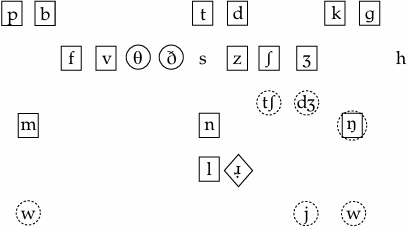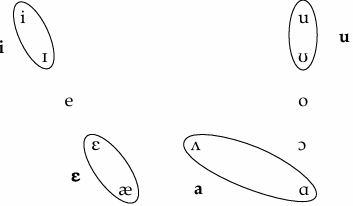


 Grammar
Grammar
 Tenses
Tenses
 Present
Present
 Past
Past
 Future
Future
 Parts Of Speech
Parts Of Speech
 Nouns
Nouns
 Verbs
Verbs
 Adverbs
Adverbs
 Adjectives
Adjectives
 Pronouns
Pronouns
 Pre Position
Pre Position
 Preposition by function
Preposition by function 
 Preposition by construction
Preposition by construction
 Conjunctions
Conjunctions
 Interjections
Interjections
 Grammar Rules
Grammar Rules
 Linguistics
Linguistics
 Semantics
Semantics
 Pragmatics
Pragmatics
 Reading Comprehension
Reading Comprehension|
Read More
Date: 2024-03-23
Date: 2024-05-04
Date: 2024-03-02
|
Portuguese–English
The overlay of the L1 consonant phonemes onto the target English inventory results in the following:

Other Portuguese phonemes are /ʎ, ɲ/.
Missing target phonemes in L1 include /θ, ð, tʃ, ʤ, ŋ/. Of these, the first two have the substitutes [t, d] respectively. The sounds [tʃ] and [ʤ] exist in Portuguese as the allophones of /t/ and /d/ respectively before /i/. Thus, we can expect problems when the targets /t/ and /d/ occur before /i/, as in teacher, difficult, where the common renditions are [tʃ] and [ʤ], respectively, for the initial sounds. The sound [ŋ] is phonetically present before a velar stop.
As in other Romance languages, Portuguese voiceless stops are unaspirated and create problems for learners in dealing with English aspirated targets. In addition, no obstruent of Portuguese, except /s/, can occur in syllable-/word final position. Consequently, English words with such demands receive an epenthetic vowel.
Nasals do not occur in final position either. The result is the nasalization of the previous vowel in English targets (e.g. from [fɾã]).
Liquids present both phonetic and distributional challenges. The lateral, /l/, is phonetically not very different from that of English (i.e. it is ‘dark’); in syllable-final position, however, it is very much vocalized and becomes a [w] (e.g. Brazil [braziw]). The target word from a brand name of an analgesic Advil puts together three pattern clashes between L1 and L2. The typical rendition of this word as [aʤiviw] is easily explainable: since /d/ is not allowed in syllable-final position, an epenthetic vowel [i] is inserted; now that /d/ is followed by an [i] it turns into the appropriate allophone [ʤ]; the final [w] is accounted for by the above-mentioned allophonic rule of the lateral.
The two r-sounds of Portuguese, alveolar tap [ɾ] and velar/uvular fricative [x/χ], are phonetically very different than that of English /ɹ̣/. Substitutions of English targets vary depending on the word position dictated by L1 (i.e. [x/χ] in initial position, [ɾ] otherwise).
Glides /w, j/ create problems similar to those we observed in Greek–English mismatches; they are produced as high vowels /u/ and /i/ respectively, and give the impression of separate syllables.
The vowel mismatches between the two languages are shown below.

The syllable structure of Portuguese, which can be described as (C) (C) V (C), can match English demands in a limited fashion. A final single coda is possible only if the consonant is /s/ or a liquid. Also, the double onsets can only have the following structure: C1 = stop or /f/, C2 = liquid. Any other English target onset predictably suffers a modification.
Portuguese stress tends to go on the penult; thus anything different demanded by English may prove difficult for learners.
Although Portuguese leans more toward the ‘stress-timed’ pattern (Brazilian Portuguese less than European Portuguese), it does not have the same vowel reductions as those of English. This, coupled with the different lexical stress, results in difficulties in target rhythmic patterns
The following summarizes the major trouble spots:
• missing target phonemes /θ, ð, tʃ, ʤ, ŋ/;
• different allophonic/distributional restrictions;
• aspiration;
• salient phonetic differences: non-lateral liquid;
• insufficient separation of target vowel contrasts;
• onset/coda clusters;
• stress;
• rhythm.
|
|
|
|
4 أسباب تجعلك تضيف الزنجبيل إلى طعامك.. تعرف عليها
|
|
|
|
|
|
|
أكبر محطة للطاقة الكهرومائية في بريطانيا تستعد للانطلاق
|
|
|
|
|
|
|
العتبة العباسية المقدسة تبحث مع العتبة الحسينية المقدسة التنسيق المشترك لإقامة حفل تخرج طلبة الجامعات
|
|
|